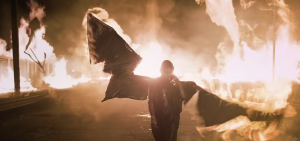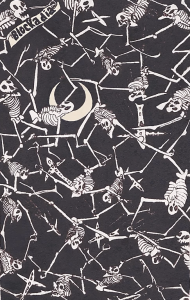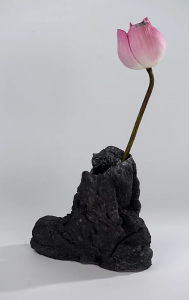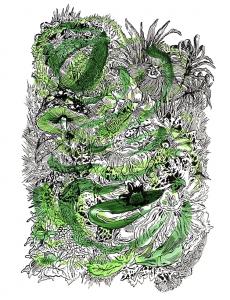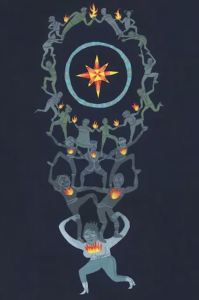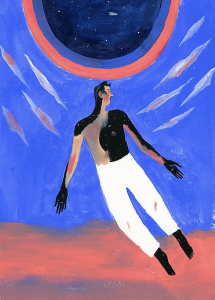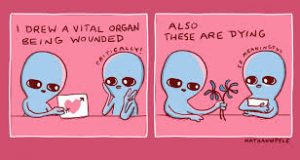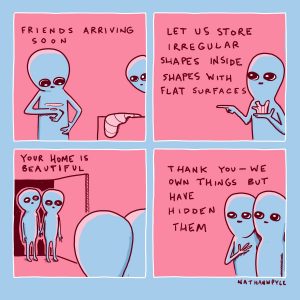We’re each of us alone, to be sure. What can you do but hold your hand out in the dark?
–Ursula K. Le Guin, “Nine Lives”
It is hard to maintain a grip on reality when every news headline feels like a plot point from a pandemic science fiction novel. Attempts to regain some semblance of normalcy range range from heartwarming (like the townspeople of Collesano, Italy singing Ave Maria from their balconies), to harmful and in some cases, extremely stupid (really? You want to protest social distancing restrictions because you refuse to wait a bit longer for a haircut?). Living through the era of COVID-19, it is hard to say when it will all go back to normal, and what exactly that new normal will look like.
As humans, we are comforted by the idea that everything happens for a reason and that we have some form of control over what happens in our lives. Pair that with the uncertainty generated by a global pandemic, and you have got a recipe for existential terror with a potential side of total nihilism on your hands. As our current global situation and its potential outcome remain unclear, the importance of science fiction as a genre that dares to explore the world of “what-if” is undeniable.
Arthur C. Clarke defines science fiction as “something that could happen – but you usually wouldn’t want it to.” But what happens when it does? With students out of school, millions out of work, and those fortunate enough holed up at home, the everyday things that we used to lean on to help define who we are–to help us feel human–have become inaccessible. As sports games, concerts, and religious services are cancelled, elbow bumps replace hugs, and phone screens replace people, what does maintaining a sense of shared humanity look like? How do we hold onto our empathy as the distance between us and the things and people that we love feels increasingly large and the world around us becomes increasingly small? As you have most likely discerned from the title, I feel that science fiction can offer an answer.
- I have got one word for you: positionality. Recognize yours.
If I had not attended a small liberal arts college in New England where terms like “intersectionality” and phrases like “eat the rich” are tossed around somewhat frequently, I may not have stumbled across the definition of positionality until much later in life. Essentially, it is the idea that your race, class, gender, sexuality, and ability status, personal values, and location in time and space will affect the way in which you experience the world around you. But why is this important, you ask?
In his short story “Nothing Happened in 1999,” Fabio Fernandes discusses a future in which humankind has accidentally discovered time travel. The residents of the future have begun to use time travel as a way to escape the present by returning to “Safe Years,” years in which “anything could have happened – except that it didn’t.” The narrator notes that 1999 is considered a Safe Year, although many disagree, as they argue that many things happened in 1999 “outside the Anglo-American sphere of influence–most of the things that happened in the world, actually.” Here, Fernandes acknowledges the danger of using the Anglo-world as a global reference point. If we only focused on the ways in which inhabitants of technologically developed, predominantly white, English-speaking countries perceived the world, what impression would that leave us? It becomes an issue of representation. An issue of diversity. An issue of positionality.
As many take to various forms of social media to express solidarity, the phrase “we are all in the same storm, not in the same boat” has become popular. It means that while we may all face this pandemic together, its effects seen from an individual to a larger scale will differ widely. My positionality and my reality during this pandemic are different from those of everyone else. As a college student coming from a middle-class family, I have been lucky enough to return to a safe home and finish my semester remotely with a somewhat low degree of financial stress. As a person of color, it pains me to witness the racial discrimination against Asians that has risen over the course of the pandemic. And I know that my experience here is worlds away from that of my family in the Philippines, living in the small rice farming town that my mother grew up in, hours away from a hospital with the facilities to give proper care to a patient with COVID-19. I have to recognize that, too. Understanding one’s positionality and inherent privilege, or lack thereof, is hard. And while it can be difficult to look inward before we attempt to empathize outwardly with others, that makes it even more important.
- Try to not be an asshole.
I hope that this one is the most straightforward. But seriously. Check pretty much any news outlet, and you can find stories of Asian-presenting people being harassed in the streets and on the subway. Cases upon cases of hand sanitizer bought to be sold at a heightened price for profit. Protestors yelling that their constitutional rights are being infringed upon because social distancing restrictions threaten their identity as freedom-loving Americans. In “Think Like A Dinosaur,” James Patrick Kelly explores a world in which society is ruled by apathetic and ruthless dinosaurs that regard human life as expendable. We know what a lack of empathy can look like. But now, our global community needs it more than ever. But what does empathy look like in a remote world?
In “A Compassionate People,” David Grigg tells the story of Carl Jacobs, a doctor who had been tasked with keeping an alien survivor of a spaceship crash alive. At the beginning of the short story, Jacobs is informed by Drage, a government official, that he must terminate the alien’s life support. The project had gone on for years, and the alien was barely alive, floating inside a tank without any means of communication. Published eight years after euthanasia was legalized in Australia, its place of publication, the title “A Compassionate People” leaves room for interpretation. While Jacobs wants to keep the alien alive so that it may have the chance of reaching a form of life that surpasses simple subsistence, Drage argues that the right thing to do is free the alien from its suffering. As the characters toy with the possibility that the alien and its counterparts were traveling to Earth to warn its inhabitants of an impending supernova, it is implied that the compassionate heroes of the story could well be the since-deceased aliens, who were possibly attempting to save their human counterparts before it was too late. Here, Grigg celebrates multiple forms of compassion–the recognition of which is essential during a global crisis.
Now, in the real world, empathy and compassion can take so many different forms. It can mean buying a gift card from a local business to help it stay afloat. Expressing solidarity with essential and healthcare workers online. Buying groceries for your elderly neighbor so that they can avoid putting themselves at risk. This is also the first and maybe the last time in our lives that by staying at home on the couch and preventing the spread of disease we can call ourselves American heroes. Take advantage of it. Be kind to others. And learn to be creative with your acts of empathy, too.
- A good deed a day keeps the existential dread away
It’s a lesson we’ve heard since we were in elementary school–treat others how you would want to be treated. While that once meant not cutting in the lunch line or refraining from name calling on the playground, it takes on a whole new meaning in the realm of science fiction. Some of us who are optimistic about the future of the human race say that in order to obtain a future that we want, we have to imagine it first. This brings up a crucial question of representation in future building, which can take place in many forms. Afrofuturism, for example, is a movement which involves imagining an optimistic future in which black people thrive. Feminist and other works that consider the representation of women, non-gender binary conforming individuals, and people of color are more important than ever, as they remind us that there is great empathy in daring to envision a future for people other than ourselves.
As the pandemic brings daily reminders of our human mortality and fallibility, this
is especially relevant as our global community considers how we may begin to imagine a future for ourselves and for generations to come. In Ken Liu’s short story “Mono No Aware,” Hiroto is the last surviving member of the Japanese race aboard a spacecraft with sails propelled by solar rays. When one of the sails tears and Hiroto is the only one with the skills to leave the ship and repair it, he is forced to choose between using the last of his fuel to return back to safety or repair the ripped sail and save the lives of everyone on board. Here, there is a call for empathy and a form of collective heroism that resonates with the global crisis today. Put into words by Hiroto’s father, “individual stones are not heroes, but all the stones together are heroic.” With healthcare and other essential workers facing the virus on the frontlines, a new definition of heroism has emerged at a time in which the world needs it the most.
This is not to say that we are only able to perform acts of kindness and care during the era of COVID-19 if we are classified as essential workers. Octavia Butler’s “Speech Sounds,” written two years after the beginning of the AIDS epidemic, takes place in a society that has been ravaged by a virus that has rendered oral communication virtually impossible. With many suffering from issues of speaking or comprehension, the world has become increasingly violent, and human connection virtually inaccessible, a novum which feels especially relatable today as social distancing measures and efforts to stay safe can feel paradoxical to the human desire to build relationships. The ending of “Speech Sounds” implies that Butler’s protagonist, Valerie, chooses to save two children after their mother is killed. In the final lives of the story, Valerie introduces herself to her two new charges–a seemingly small act of kindness with incredible weight.
We can find examples of this in real life today. Last week, my dad drew a rainbow on a piece of posterboard and hung it in the window facing our neighbor, whose husband is suffering from late stages of pancreatic cancer, to show her that we’re thinking of them. Some of my friends at school, unable to return home, have been invited to stay with local families and welcomed with open arms. As we live through times as unpredictable as these, it is so important to remember that individual acts of empathy, no matter how small, matter.
- Appreciate communion (that goes for atheists, too).
When I say the word communion, I don’t mean to conjure reminders, for those of us that were raised christian, of the stale taste of bread and the sweetness of watered-down wine. Instead, I want to speak to a different form of communion–one that takes place when we are lucky enough to stumble upon a sense of unity with others. With those of us with access to technology glued to our screens for at least part of the day, maintaining a connection to the world around us can feel, at times, daunting. My mother, who used to go to church every week, now wakes up early on Sundays so that she can watch a livestream of a local Catholic service. My roommate and I used to study together in our apartment, but now we still facetime each other while we’re working. While we don’t have much to catch up on, sitting in each other’s presence and listening to the sounds of pencils scratching over notebooks and pages turning feels like we’re reclaiming a little, tiny piece of our old normal.
The way in which technology can foster empathy and human connection can be seen in “Act of Faith” by Fadzlishah Johanabas, which follows the life of a robot purchased by Jamil, the worried son of Daud, a widower of ten years. Daud names the robot Sallehuddin, and treats him as a son. With Jamil worried about his father but unable to live at home because of his line of work, Sallehuddin suggests that Jamil purchase an application that would allow him to communicate with his father through Sallehudin. When Daud has a heart attack, Sallehuddin calls on Jamil using the program, and Daud is able to hear Jamil’s voice through Sallehuddin’s lips. Through Sallehuddin, Jamil is able to comfort his father in a manner which would not have been possible if not for the technological advancements made in their fictional society. While we are far from a form of technology as advanced as Sallehudin, those of us that have access to electricity and wifi to stay connected via text messages, Facebook, What’sApp and various other messaging platforms. Speaking from personal experience, by no means does it replace being physically close to my friends and family. But it is comforting, all the same.
At the same time, as humans, our need for human connection extends far past what we are able to simulate through our use of technology. We need something more–a feeling that we can connect with others on an emotional and spiritual level that can be quite powerful and at times, inexplicable. Ursula K. Le Guin’s “Nine Lives” follows the actions of nine young and extremely capable clones as they attempt to work with Pugh and Martin, two survivors of a famine that ravaged the planet Earth. When an earthquake occurs causing a collapse in the mine in which the clones were working, Pugh and Martin are able to find only one survivor, a clone named Kaph, who has extreme difficulty in understanding how to interact with his non-clone counterparts. When an earthquake occurs as Martin is working by himself in the field, Pugh risks his life to save him, prompting Kaph to ask him whether he loves his partner, and how he would know if he did. I referenced Pugh’s reply at the beginning of this manifesto; he’s not sure, but he tells Kaph “we’re each of us alone, to be sure. What can you do but hold your hand out in the dark?”
In a way, many of us resemble Kaph. We have had our worlds turned upside down, and are now trying to make sense out of the pieces left behind while still holding on to our humanity in the process. By no means is it easy. But boy, is it important. Earlier, I mentioned how essential communion is now, as the human race faces a crisis that we did not predict nor see coming. The question of how we hold onto our empathy, our ability to connect, when we can no longer do so physically is one that we must answer.
At the end of “Nine Lives,” as Kaph and Pugh crawl into their sleeping bags, Kaph looks at Pugh, “the stranger who held his hand out in the dark,” as he says goodnight, before Kaph finally replies, “repeating across darkness, benediction.” Especially now, remembering our empathy and everything else that makes us human, it can feel just like that.
Benediction.



